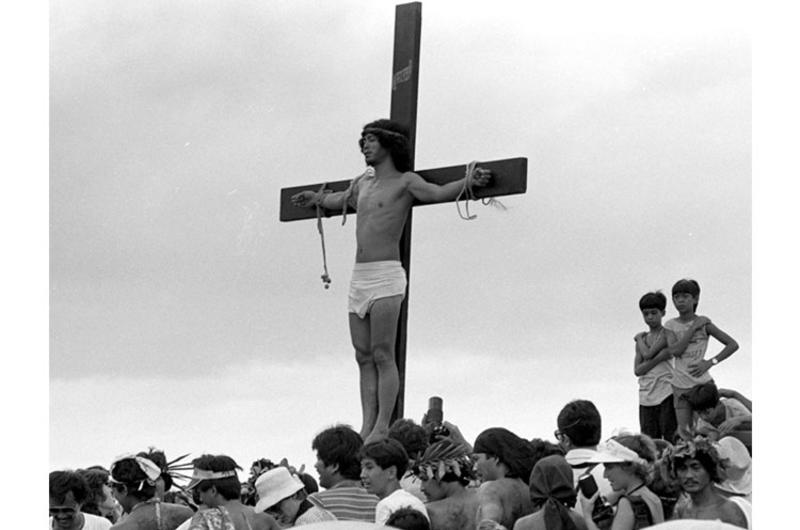

This website was created and maintained from May 2020 to May 2021 to commemorate the 75th anniversary of Stars and Stripes operations in the Pacific.
It will no longer be updated, but we encourage you to explore the site and view content we felt best illustrated Stars and Stripes' continued support of the Pacific theater since 1945.
16 Filipinos 'join' Christ on crosses

A Good Friday ceremony in San Fernando, Pampanga Province, Philippines, in April, 1985.
By Scott Schumaker | Stars and Stripes April 7, 1985
SAN FERNANDO, Philippines — Two Filipinos allowed themselves to be nailed to crosses here Friday, joining a reported 15 other people around the country who re-enacted the crucifixion of Jesus Christ nearly 2,000 years ago.
According to U.S. and Philippine press reports, 16 crucifixions were carried out throughout the country in an annual orgy of pain which dramatizes Holy Week. One of those crucified was a woman.
At the Philippines national prison at Muntinglupa, a condemned killer allowed himself to be nailed through the hands and feet to a cross, while at Bulacan, a Manila suburb, a Filipino-American underwent crucifixion for the sixth straight year.
ACCORDING TO the Manila Daily Express, Donald Rexford said this was the last time he would undergo the ordeal.
"I have my wish," Rexford told the newspaper. He said he will finally meet his father, a U.S. soldier in the Philippines during World War II, because a sister and brother had agreed to pay his airfare to the United States.
Rexford said he and his father had been exchanging letters for more than a year, the newspaper reported.
In San Fernando, one of the two men who submitted to the ordeal cried, "I do this so you can remember the sufferings of Christ," as nails were driven through his hands and feet into a wooden cross.
According to Ric Tuazon, Clark AB community relations specialist and a member of a tour group of 165 Americans from the air base who witnessed the event, a language barrier may have sparked the re-enactments of Christ's death.
Historians argue over the beginning of the dramatization of the Crucifixion, he said. Many believe it started when the first Spanish priests came to the Philippines, in the 16th century. Because the priests couldn't speak the language, they had to act out their message.
As to why the crucifixions are carried out now, Tuazon said Filipinos concentrate on Christ's death rather than on his resurrection.
Like many early Filipinos, some of the Americans from Clark who witnessed the event Friday in San Fernando — where the largest crucifixion is carried out each year — understood it, while others felt it was an excessive display of religious fervor.
"It was very moving to see the kind of dedication it takes to go through with that," said Air Force Capt. Marc B. Sher. Sher was only about two feet away from one of the men as the nails were driven through his flesh.
"He was totally engrossed in what he was doing. All I could think of was he must be dedicated. I know I wouldn't do it."
On the other hand, Airman Krystal Smithelin said, "I think it's disgusting." Friday's was her first trip to a crucifixion and, she said, it would be her last.
"I think there are more constructive ways to show your faith," she said.
Tuazon said neither the Philippine government nor the Catholic Church condones or condemns the crucifixions, perhaps because these events create unity between Filipinos.
Air Force Catholic Chaplain Lt. Col. Carl J. Bagge agreed that the ritual may be unifying, but said the mutilation was upsetting.
"We're dealing with different cultures, and being American makes it difficult to pass judgment," he said. He added that he frowns on the extreme dramatization of Christ's death.
Elsewhere, the ritual was not quite so realistic.
Pacific Stars and Stripes correspondent Mike Van Hoecke reported from Angeles City, just outside Clark, that residents had erected a \bamboo chapel on Friendship Highway earlier in the week in a celebration called Friendship Pabasa '85.
Celebrants began chanting the pabasa, an account of Christ's life, over loudspeakers last Monday.
Thursday, devout believers called flagellants began carrying heavy crosses up the highway while others lashed themselves with whips to symbolize Christ's suffering.
At noon Thursday, one flagellant was lashed to a cross for three hours.


